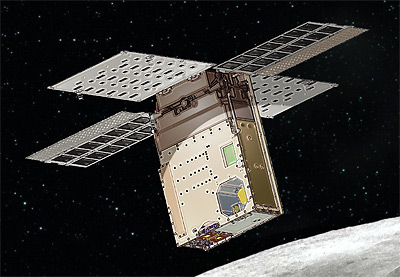Thank you very much for visiting Gunter's Space Page. I hope that this site is useful and informative for you.
If you appreciate the information provided on this site, please consider supporting my work by making a simple and secure donation via PayPal. Please help to run the website and keep everything free of charge. Thank you very much.
Lunar Flashlight

Lunar Flashlight [NASA]
Lunar Flashlight is a mission that was selected in 2014 by NASAís Advanced Exploration Systems (AES) by a team from the Jet Propulsion Laboratory, UCLA, and Marshall Space Flight Center. This innovative, low-cost concept will map the lunar south pole for volatiles and demonstrate several technological firsts, including being the first CubeSat to reach the Moon, the first planetary CubeSat mission to use green propulsion, and the first mission to use lasers to look for water ice.
The Lunar Flashlight mission spacecraft maneuvers to its lunar polar orbit and uses its near infrared lasers to shine light into the shaded polar regions, while the on-board spectrometer measures surface reflection and composition. The Lunar Flashlight 6U spacecraft has heritage elements from predecessor systems including JPLís INSPIRE (INterplanetary NanoSpacecraft in a Relevant Environment), MARCO (MARs CubeSat One) and JPLís experience with spectrometers, including the Moon Mineralogy Mapper (M3)on the Chandrayaan 1 mission. The mission will demonstrate a path where 6U cubesat could, at a much lower cost than previously thought possible, explore, locate and estimate size and composition of ice deposits on the Moon. It is a game-changing capability for expanded human exploration, planetary science, heliophysics, and other relevant instrument applications.
Lunar Flashlight was one of 13 cubesats planned to be carried with the Artemis 1 (Orion CM-002) mission into a heliocentric orbit in cis-lunar space on the maiden flight of the SLS (Block 1) iCPS launch vehicle in 2022. As it was not ready in time, it was dropped from the launch and remanifested on the Nova-C IM-1 launch, but was eventually launched on the Hakuto-R M1 mission.
| Nation: | USA |
|---|---|
| Type / Application: | Lunar orbiter |
| Operator: | NASA Jet Propulsion Laboratory |
| Contractors: | NASA Jet Propulsion Laboratory |
| Equipment: | |
| Configuration: | CubeSat (6U) |
| Propulsion: | ? |
| Power: | 4 deployable fixed solar arrays, batteries |
| Lifetime: | < 2 years |
| Mass: | ~14 kg |
| Orbit: | Lunar orbit |
| Satellite | COSPAR | Date | LS | Launch Vehicle | Remarks | |
|---|---|---|---|---|---|---|
| Lunar Flashlight | 2022-168B | 11.12.2022 | CC SLC-40 | Falcon-9 v1.2 (Block 5) | with Hakuto-R M1 |
References:
- NASA SSERVI: Lunar Flashlight
- Payam Banazadeh, Andreas Frick: Lunar Flashlight & NEA Scout – A NanoSat Architecture for Deep Space Exploration
